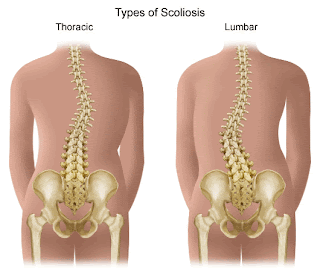> Spinal curvatures
Spinal curvatures
Spine is vertical direction, but not right. In length, it shows the curves, some in the sagittal plane, known as anterior-posterior curvature, and others that can be seen in the frontal plane, known as lateral curvature. Anterior-posterior curvatures of the spine is a specifically human nature and their occurrence is related to bipedal walking. They have an important role in maintaining normal body position, both in positions static, as well as in walking, and the role of having to absorb some forces exerted on the spine. For various reasons, spine curvatures can change the radius of curvature, giving becomes more pronounced and pathological, which distorts the spine.
What is scoliosis?
Scoliosis is a three-dimensional deformity of the spine (three plans), which may occur in the cervical, thoracic or lumbar, exhilarating torque to one or more vertebrae and cause deformity of the thorax, abdomen or areas of Par vertebral (near the vertebrae). Scoliosis may be structural, when the column is curved and rotated and unstructured, only when the column is curved. Scoliosis by orthopedic doctor defines the location, direction and magnitude of curvature and, if possible, by its causes. Severity of scoliosis is determined by the size of the curvature and angle of trunk
Risk Factors
Spinal pain may occur in case of prolonged activity, which involves sitting position or on the feet. Once lateral curvature of the spine (C-shaped), may be a compensatory curve (the S-shaped) for balance. Scoliosis can cause severe and respiratory problems. An important risk factor is the size of curvature: with how it is higher, with both increases and risk. At a bend of 20 degrees, only 20 percent of cases progressing. At 30 degrees, the risk factor reached 60 percent and a curvature of 50 degrees, the risk is 90 percent.
Read more on remedies for Sciatica Pain Treatment and Yoga for Spinal Cord. And also get useful Remedies for Spinal Headaches
Tuesday, November 1, 2011
Diseases of the Spine, Scoliosis
Posted by Tyo at 9:36 PM
Labels: Diseases of spine, Risk Factors of spine, scoliosis, Spinal curvatures, Spinal pain, What is scoliosis
Subscribe to:
Post Comments (Atom)
0 comments:
Post a Comment